David MacHale
Senior Director - Brand Marketing, Travelport
Share article
Note:
This is part two of a three-part blog series on ‘Digital Advertising and Marketing for Travel Brands’.
COVID-19 means that advertising spend is being more heavily scrutinized than ever before. As a marketer, if you’ve recommended to your CFO why you should still be advertising — you’ll now want to back that up with an updated activation plan that talks about your new approach. So, in this next blog, developed in conjunction with Imperic Media, we wanted to examine if there’s a change in the people you’re targeting, and how you can target them.
Who is traveling, when are they booking, and where they are going? All of this has been turned on its head because of COVID-19. This means you’ll need to overhaul your audience and targeting strategy. Later in this piece, we’re going to look at the ‘usual suspects’ (Google and Facebook) in audience building, but before that, I wanted to also look at an invaluable data source that provides a window into millions of bookings that take place on travel agents websites and points of sale — and that’s the data that’s shared across the world’s major global distribution systems.
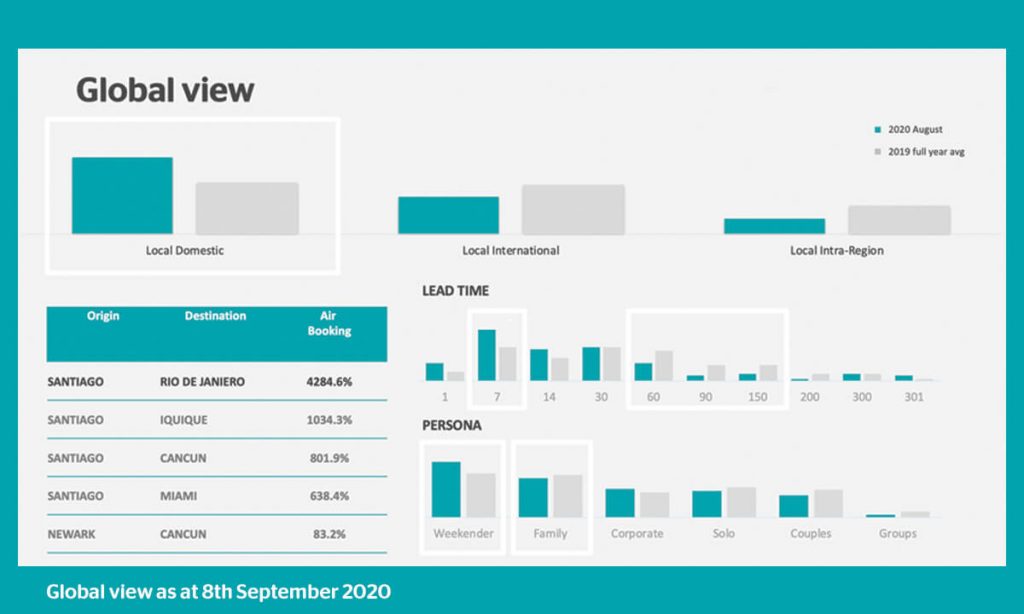
If we look at a global view of bookings today versus 2019, what’s interesting is the shift in local domestic bookings and local intra-region. This is important to consider when you’re looking to see if you should be spending more money to promote domestic routes versus international.
Next on the left-hand side, it’s also important to see where the growth is in the market. Santiago had a peak of activity the week commencing August 31st as an Origin City, that route went from a small amount of activity to a large increase in a number of days. Access to this real-time booking data and traveler behavior gives you an added advantage as it can help pinpoint which routes you may want to promote more heavily.
Also, what’s important to look at is the lead time between booking and traveling. As that can tell you when you may wish to increase particular ad spend to hit the sweet-spot moment. On a macro level, the lead times in 2019 were spread across 7-60 days, but now in 2020, the lead time has dramatically shifted to 7 days.
And finally, who are these people that are traveling? Again, from our data, we can decipher that there has been an increase in weekender personas, and family personas have maintained a high volume of the bookings by persona.
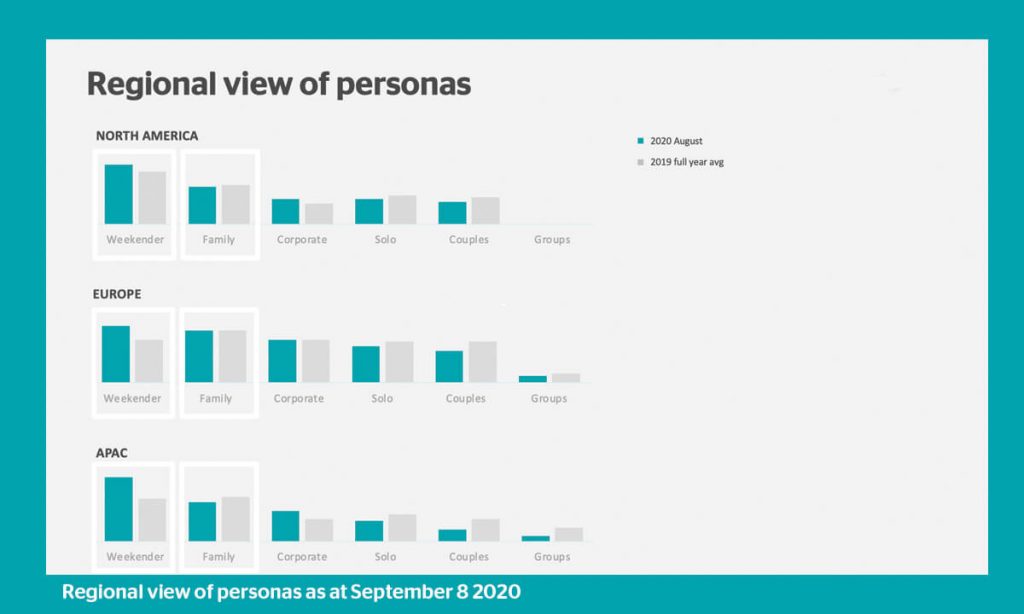
If we drill down and look into the data at a regional persona level — North America has seen an increase in weekender persona bookings and a slight decrease in family persona bookings, but still, families represent a larger proportion of bookings over other personas. This trend is repeated in Europe and APAC.
Now we’ve talked about one large data source, let’s talk about another, Google. First, let’s investigate how the current crisis has changed online advertising, and how this is altering consumers’ travel search queries.
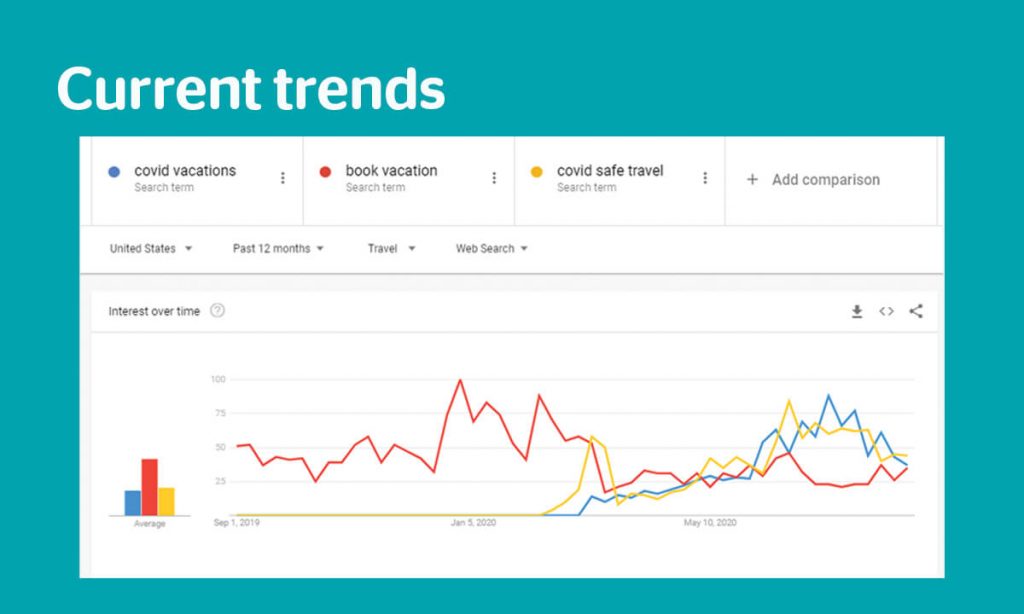
Looking at Google Trends’ most recent search data, it is clear to see that what consumers are searching for has changed. Typical holiday and vacation search queries have declined (red)— and are being replaced by new search queries around COVID-19 and safety in travel. Clearly, consumers are still interested in travel, even if their options have been restricted — however, safety is now a key theme. So, what does this mean for agencies?
By looking at these rich sources of data, we can better inform both our audience segmentation and the digital tactics that we deploy.
Before we explore how to target and advertise to consumers, we need to think about how to segment them. The current market situation means that many consumer’s travel plans have been postponed. For this reason, it makes sense to focus your attention, resources, and budgets on advertising to people who are in the inspiration stage — as they may be there for some time yet.
I’d recommend you start by building a remarketing audience, targeting website visitors or app users — you can find remarketing lists in your Google Ads, Google Analytics, or Facebook ad platforms. Build those remarketing lists early to stay a step ahead. Plus, going through this process will help you find weak spots in your marketing plan.
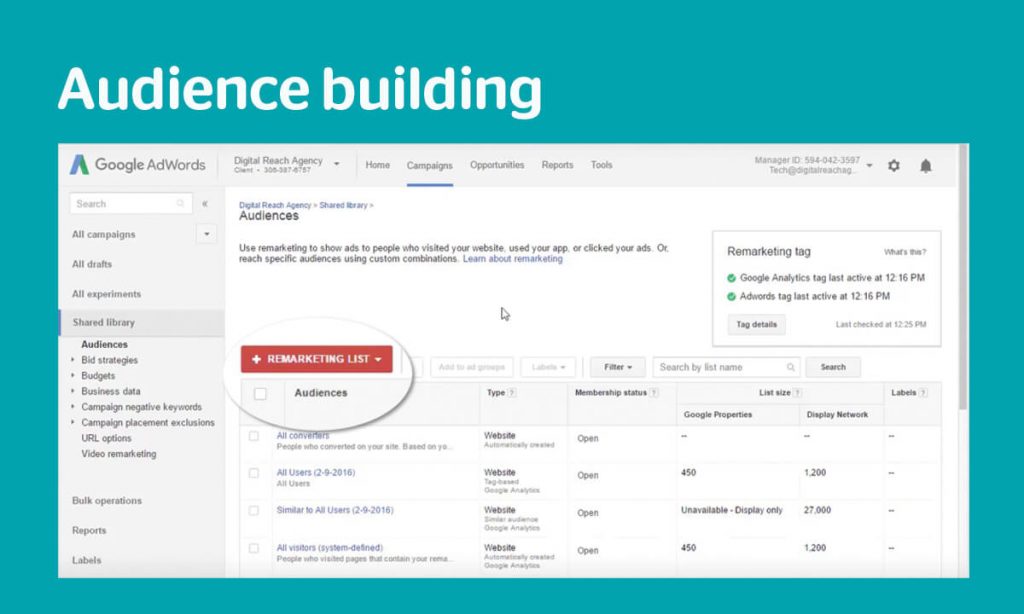
When segmenting your website or app visitors, you could look at groups such as previous bookers, frequent buyers, users who haven’t bought this year, by persona (such as family or weekend bookers), or shopping cart abandoners.
Once you have created these lists you need to set a duration that the audience spends on each list. For example, family trip bookers— retargeting with relevant hotel and car hire messaging for all recent bookings within 90 days; or for abandoned carts within 30 days, try retargeting messaging that promotes your refund, cancellation, and safety policies.
Now you have finalized your segmentation plans and built your retargeting audiences, we can look at how to target and reach new audiences.
1. Develop lookalike audiences
Our first recommendation is to try to reach more people who look or behave like your existing customers. You should do this by making similar or lookalike audiences in both Google and Facebook. So, if you already have high value remarketing audiences created, such as previous bookers — the first thing to do with those audiences is to clone them into a lookalike audience. For example, travelers who have booked weekend breaks on your site.
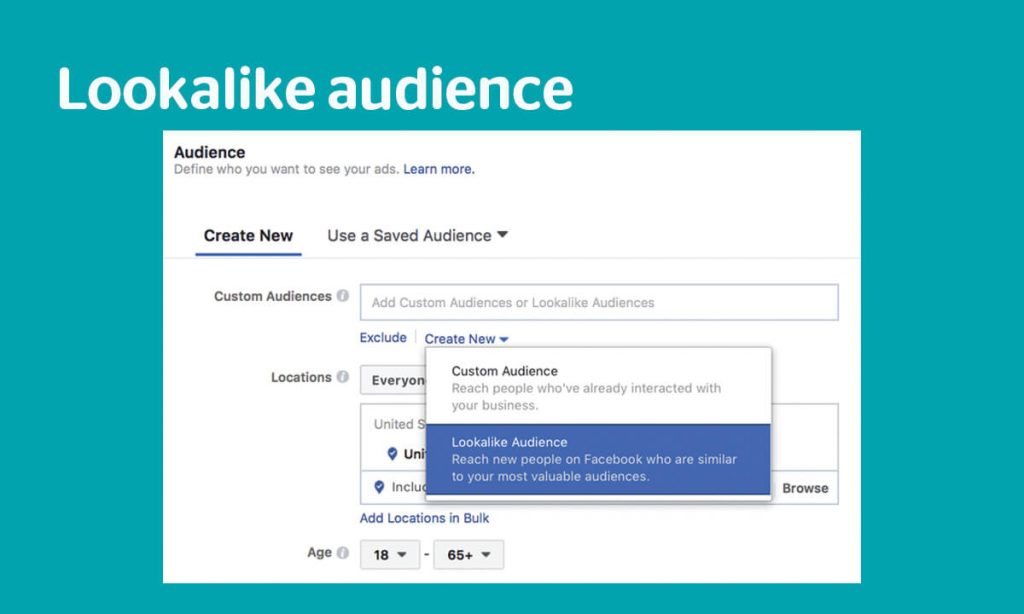
It makes sense to inspire more consumers just like these with ads about great weekend destinations. You can also use your Customer Relationship Management (CRM) data to create lookalike audiences. You can upload email addresses and phone numbers into Google and Facebook and match up with consumer’s profiles on these platforms. This is how you supercharge your advertising using your own data.
Another suggestion to help, given the current climate, is to build audiences of guests who may still be looking at hotels and destinations and create a lookalike of these audiences.
2. Affinity targeting
Let’s look now at targeting options for the inspiration stage specifically on Google Display Network and on YouTube. Google’s Affinity targeting is perfect for reaching a large audience to inspire. Affinity targeting is broad in its nature — think TV broad!
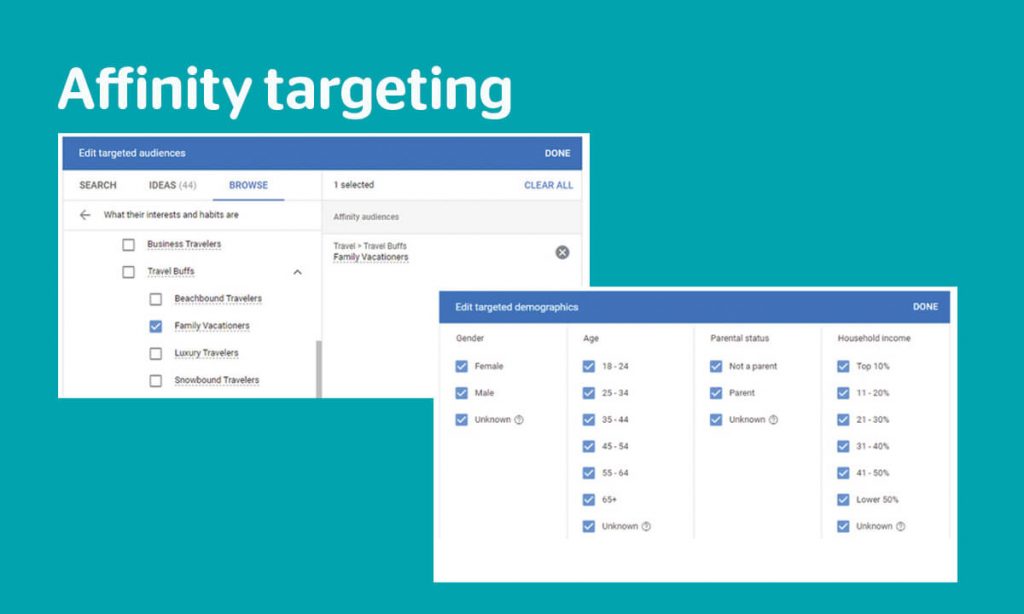
Google Ads looks at a person’s browsing history, time on the websites they have visited, and then Google associates an interest category to the person. If we take the example of family vacations here — Google’s Affinity targeting option has a pre-built family vacationers’ audience. This is a great start to reaching a new audience.
You can layer further targeting options on top of this to hone in on your ideal customers. Start with demographic filters — like parental status for family holidays, for example.
An easy way to scale up and down your advertising— especially right now —is to keep an eye on the travel green lists and only advertise regions or countries to audiences who can travel to them. As this is changing quite frequently, you may need to remove and add countries from your targeting quickly to avoid disseminating irrelevant ads that deliver no return.
3. Custom affinity targeting
If you are not getting the granularity you want from affinity targeting, you can hand-build your own ‘custom’ affinity audience for more specific targeting at the top of the funnel. Choose popular URLs of websites and articles that your audience is visiting — these could be travel guides or articles. You can also include competitors’ sites. Pop these URLs into Google’s custom affinity targeting option. This allows you to target people who like to visit these types of websites.
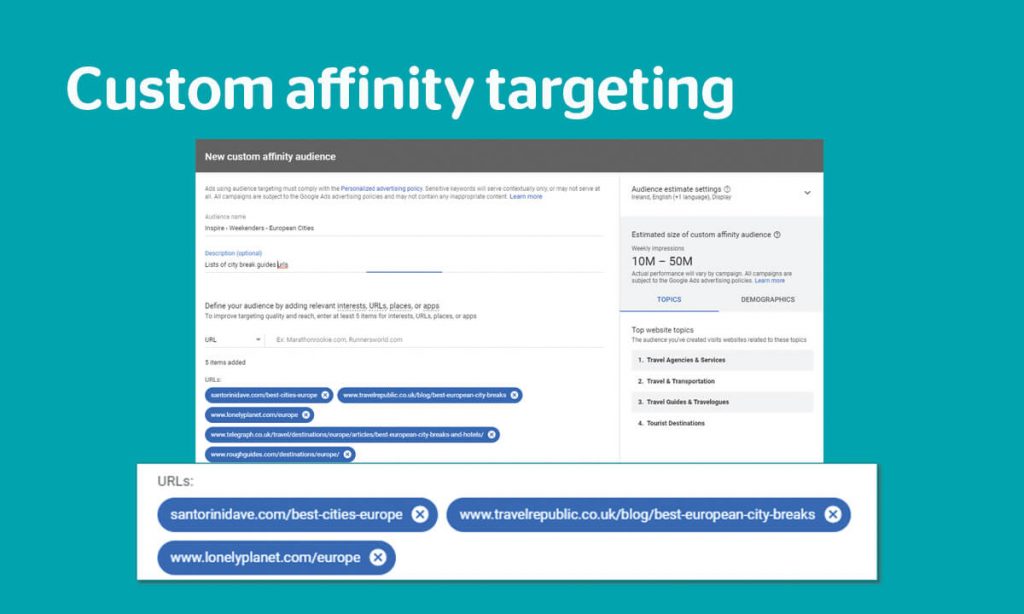
Again, layer further targeting options to pinpoint your ideal customers. Both affinity targeting options will reach a large audience. These consumers will have varying levels of intent but remember: a key result of this activity is to grow remarketing audiences, in order to get people visiting your site so you can follow up with them in their next step.
4. Google in-market audiences
To inspire consumers a bit further down the funnel and narrow your targeting further, try Google’s in-market audiences. This incorporates i) display, ii) YouTube, and iii) the search network – we’re going to talk about each in a bit more detail next.
With in-market audiences Google allows you to select from a list of categories to find customers who are in the market for your offering. This means that they’re researching products and are actively considering buying a service or product like yours. Google’s in-market audiences have incredible granularity for travel agents. You can drill down and target people who have shown a distinct interest in trips to 255 regions, countries, and city destinations.
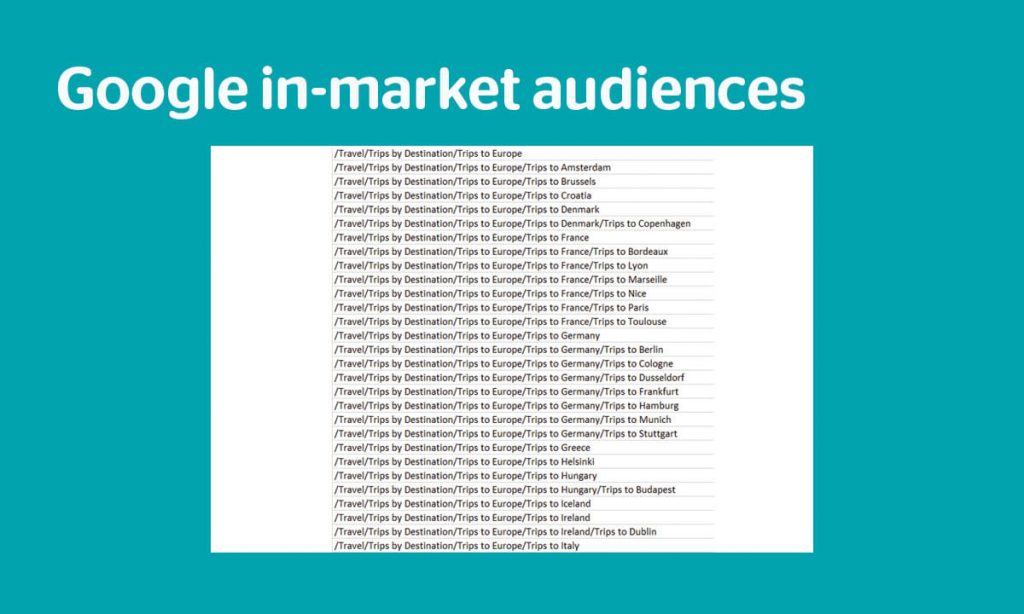
So, if someone has searched for a trip to Rome on Google, or read articles about visiting Rome, they will be deemed to be in the market for a trip to this destination and get put into the Europe>Italy>Rome category. Don’t worry if your ad didn’t show up in their search results, or if it wasn’t your article they read — you can now simply tick a box in your in-market targeting and start advertising.
You can serve the audience with more highly visual ads across the web and apps or video ads on YouTube. Remember, they may not be booking for some time yet — so inspiration is still important.
Now you have segmented your audience, here are our tips for the best advertising formats to use to inspire travelers.
1. Google’s new Discovery Ads
When it comes to advertising with Google display ads and YouTube ads — we recommend trying Google’s new Discovery Ads.
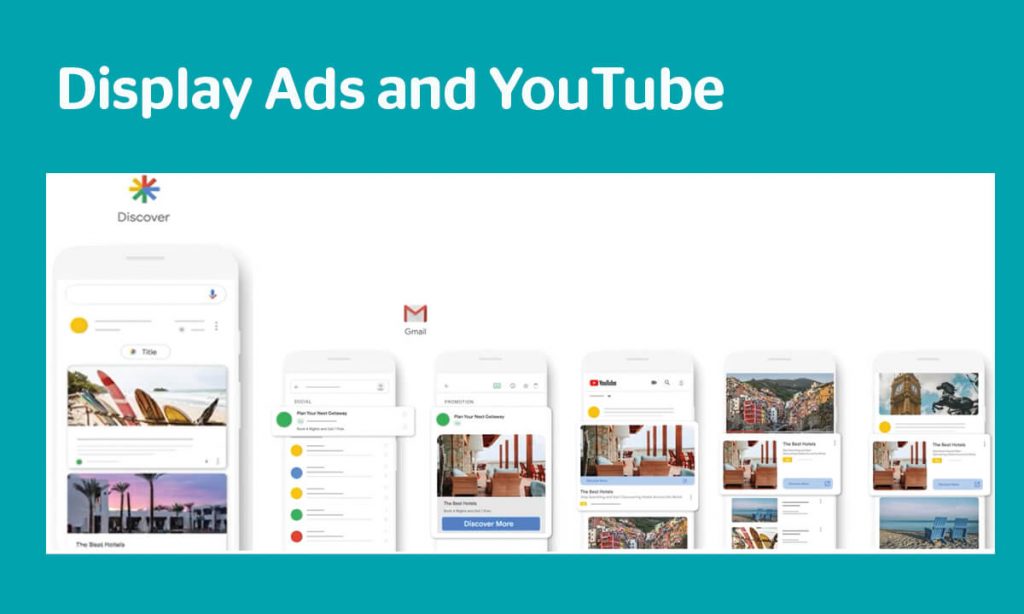
Discovery Ads are Google’s latest top of funnel play. They are similar in structure to classic display ads but behave more like social ads: large, visually rich experiences — perfect for travel advertisers. Discovery Ads can be found not only in the Google Discover Feed, which is the default home screen of your Google mobile app but also on the homepage of the YouTube app and appear in Gmail.
This makes Discovery Ads incredibly attractive for advertisers, as you are covering such a range of platforms with just one ad. They can consist of several elements such as image, company logo, title, description, and call-to-action. It’s possible to single image ads or carousel style ads. Tests show Discovery Ads get a higher Click Thru Rate (CTR) and lower Cost Per Clicks (CPC).
Early adopters always tend to get a bump in rankings and a better deal when trying out new ad formats on Google.
2.Triple Threat YouTube videos
If you have a destination video to promote you can become a triple threat on YouTube, with TrueView for action campaigns. This format will give you 3 dimensions to your ad. Your video will be accompanied by a button with a call to action and a companion banner.
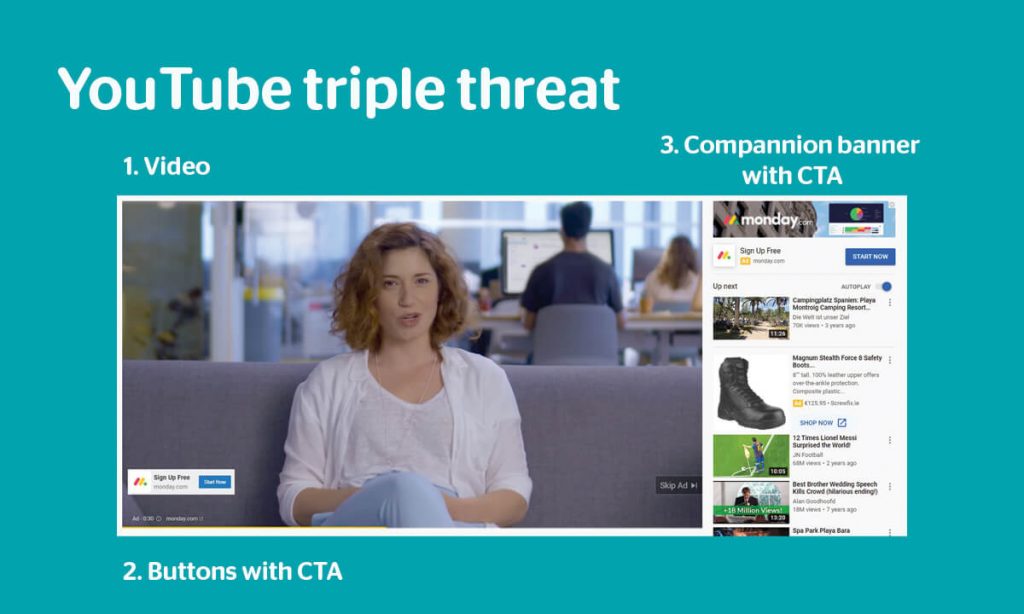
If your video is compelling enough people will click on your website. This ad format is great for developing interest in a specific destination and promising more info on site.
It’s worth noting that you can remarket to consumers who have seen your video ad, so if your video is helping create demand you can follow up when someone decides to take the next step and search for more info on the destination.
3. Facebook and Instagram lookalike audience
For your inspiration stage targeting, you can use lookalikes of previous segmented customers — either from your website audiences or from your CRM. And, you can reach and inspire new audiences using the detailed targeting options in Facebook Ad Manager. To do this, select from the demographic, interest, and behavior options that you match your ideal customer.
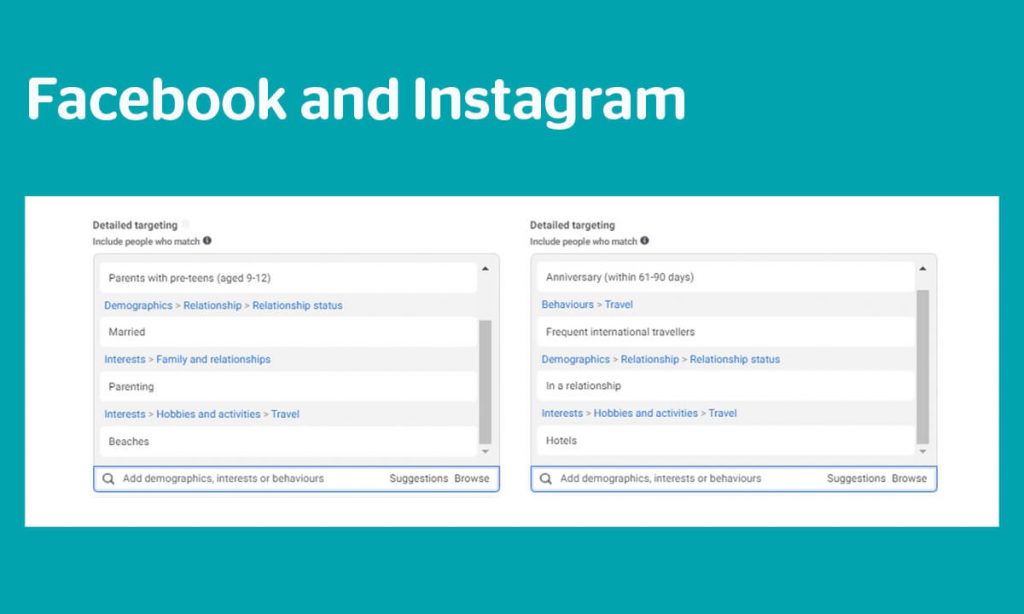
You can configure the options to segment a specific audience that matches your offerings. For example, families of pre-teen children, who want to travel to beach destinations. You can also target couples whose anniversary is coming up in the next 20 weeks, who frequently travel, and are interested in staying in hotels. It’s worth exploring the options here and testing what combinations work best. The variety of interests available is enormous.
4. Facebook and Instagram video ads and instant experience ads
At this stage of the social media journey, a good way to decide what you should promote is to consider for a moment — will someone who sees my content share it? Think about promoting ‘shareable content’ in your ads. This should also be unique to your business.
Don’t opt for regular sponsored posts here, instead use Facebook and Instagram’s more visual and experiential ads formats. Videos ads and Instant Experience ads are a great option here for 3 reasons:
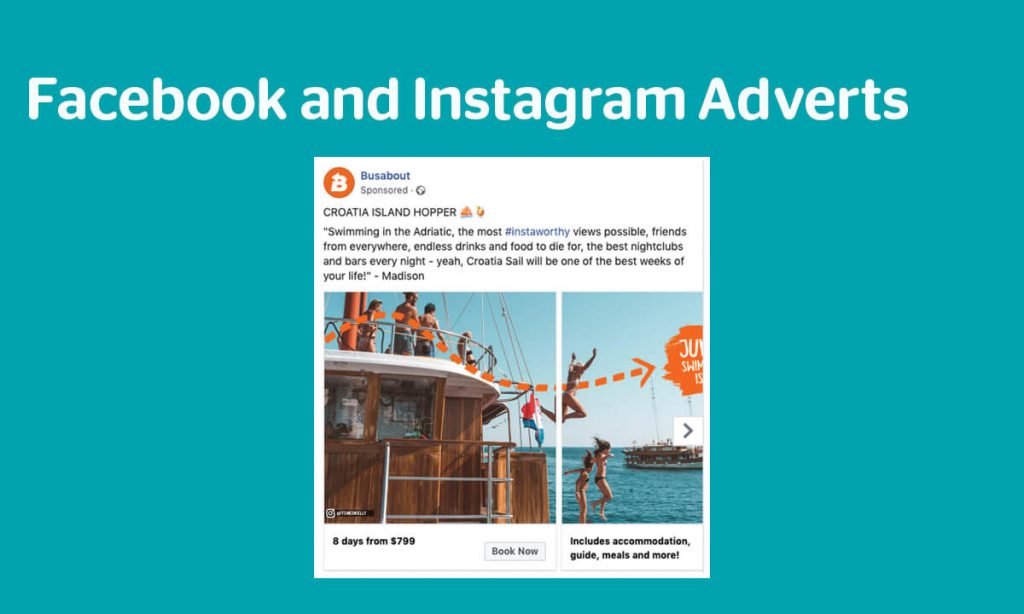
Peer to peer always works best, so why not tap into your customer’s real-life experiences and create ads with user-generated content. Travel company Busabout have switched their entire social ad campaigns to User Generated Content (UGC) after doubling the conversion rates of their ads.
5. Google Search
Using search to help generate inspiration is a different task than on display or social. It is not about showcasing a fantastic image or video as people scroll through Facebook. It’s entirely intent-driven, so you need to interpret what people are searching for prior to shopping for their trip.
Nowadays travel agencies need to be prepared to answer traveler’s questions around safety measures. As we saw with the Google Trends example, these search queries are growing — so it pays to keep an eye on what people are researching. With such little clarity on future travel plans, consumers could be trying to answer more fundamental questions about travel such as:
Creating content, guides, or articles on these topics can help customers to begin the booking process with you in mind. Create the content, and ad text with the specific keywords in mind, and then bid on these keywords to get your content seen.
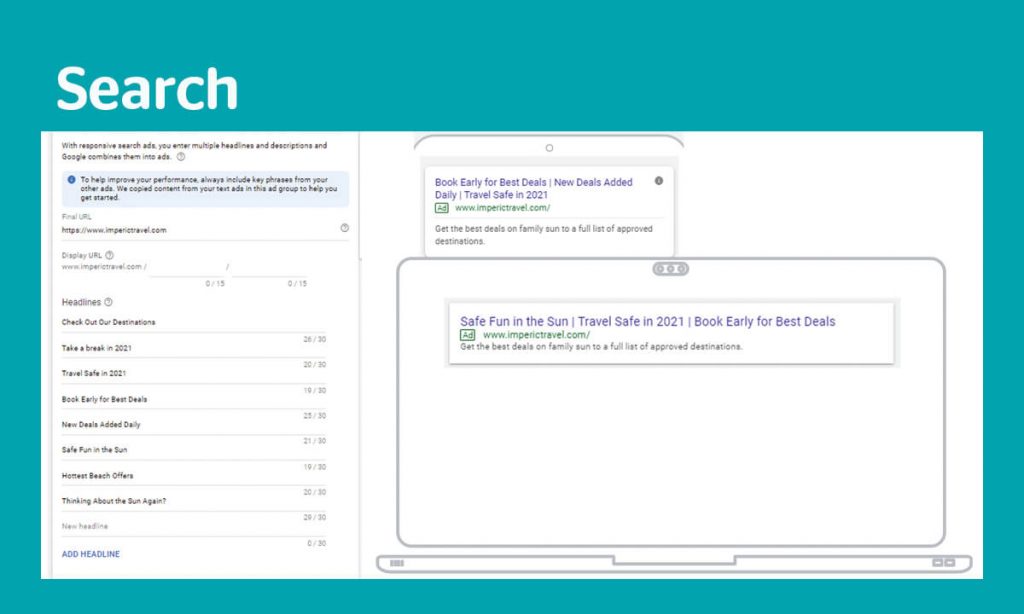
We mentioned earlier that in-market audiences are available on the search network also. When you apply an in-market audience to one of your search campaigns, you know that searchers who see your ad have already been in the market for this offering. These consumers may be at a more advanced stage of booking, and so you should be prepared to allocate more of your budget for these people.
People who return to travel soonest will expect good deals, but safety will still be their priority — especially for families. And this can take a lot of messaging to get across in one search ad, so it’s a good idea to use responsive search ads to highlight all these attributes.
Responsive search ads adapt to show more text and more relevant messages to your customers. You can enter multiple headlines and descriptions when creating a responsive search ad, and over time, Google Ads will automatically test different combinations and learn which combinations perform best.
Also, make good use of ad extensions. As well as highlighting reviews and ratings try highlighting cancellation policies, refunds, insurance, safety charters, travel protections, and special offers.
It’s a BIG TOPIC. With budgets really under the microscope today, what’s important in recovery is ensuring you are maximizing your paid advertising budget, we’ve shared a couple of budget tips along the way – but here are some final tips.